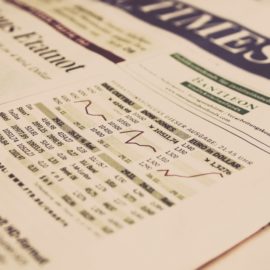

This article is an excerpt from the Shortform book guide to "Flash Boys" by Michael Lewis. Shortform has the world's best summaries and analyses of books you should be reading.
Like this article? Sign up for a free trial here .
What is latency arbitrage? How is it used against slower trading investors in the stock market?
According to Michael Lewis, the author of Flash Boys, latency arbitrage is one of the many tactics that high-frequency traders (HF) use to get an unfair advantage over average traders in the market. By using different latency speeds, HF traders can buy a stock and then sell it for a much higher price in a matter of seconds.
Let’s look at why Lewis believes latency arbitrage is a problem in stock trading, and why others disagree with him.
Latency Arbitrage (AKA Slow-Market Arbitrage)
Lewis explains that the most widespread tactic high-frequency trading (HFT) uses is latency arbitrage, or slow-market arbitrage. This is when HF traders use different latency speeds to capitalize on changes in stock prices. HF traders see changes in stock prices on one exchange and buy or sell those orders on other exchanges that haven’t caught up to the changes in stock prices. Latency arbitrage is why trading firms care so much about their latency speeds and why it matters to be a microsecond faster than their competitors.
(Shortform note: While Lewis discusses latency arbitrage within the US. stock markets, it can also be used in foreign markets. Stock prices on foreign exchanges are sometimes slower to adjust to exchange rates. Traders will purchase these stocks on foreign exchanges for lower prices (before it’s had time to update) and sell them at a higher price in the US market. According to a 2020 study, latency arbitrage costs regular investors about $5 billion dollars each year.)
Additionally, Lewis explains that the Securities Information Processor (the program that determines the best market price for a stock) has a high latency, so it’s slower to obtain and then transmit market data. HFT firms developed their own faster versions of the Securities Information Processor (SIP)—which gathers and condenses stock prices from all the exchanges—giving them a slight sneak peek of what the market will do. Then the HF traders use this advance information to capitalize on the price difference.
Because HF traders have access to faster infrastructure than investors, they can see changes in the markets before anyone else. They can then use that advance knowledge to game the market—buying a stock at one price on one exchange and then reselling it for a higher price on another exchange where the price hasn’t updated to the lower price yet.
Latency arbitrage works in the same sense as shopping in retail. If you went into a popular clothing store chain and bought a shirt on sale. You leave that store with your new shirt and go to the same store in a different location. The second location hasn’t marked down its sale items yet, so you return the shirt for full price, pocketing the difference.
SIP Timestamps Indicate a Lack of Latency Arbitrage
While Lewis believes latency arbitrage is a problem for investors, other experts disagree. In 2015, the SEC changed the SIP data to show the time by the microsecond, as well as showing when exchanges transmit data to their feeds. By comparing these two timestamps, traders can identify the latency of trades.
According to a study analyzing nine months of trading data, traders who used the SIP data actually earned three cents per 100 shares rather than losing money as Lewis claims. The study also found that around 97% of trades happen when data from both timestamps match, indicating that most trades don’t suffer from a lag in latency.

———End of Preview———
Like what you just read? Read the rest of the world's best book summary and analysis of Michael Lewis's "Flash Boys" at Shortform .
Here's what you'll find in our full Flash Boys summary :
- Why high-frequency trading (HFT) is a threat to your investments
- A look at Wall Street’s greedy response to HFT
- How Canadian trader Brad Katsuyama tried to fight the problem






